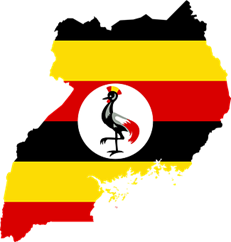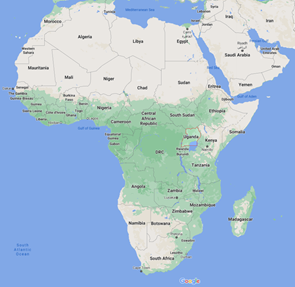Introduction to Uganda
The Republic of Uganda is located in EastCentral Africa, surrounded by Kenya, South Sudan, the Democratic Republic of Congo, Rwanda and Tanzania. Due to its location, the country is characterized by lakes, the Nile, primeval forests and savannahs. While the north is dominated by savannah and a semi-arid climate, the edges of the Central African rainforest begin in the south. Until 1962, Uganda was part of Great Britain as a colony. Today, however, the country is independent and is ruled authoritatively by President Yoweri Museveni. The official languages are Swahili and English, but the former is only spoken by the police and military whereas English is taught from the first grade. Additionally, 40 languages are used in the daily life. Currently about 41 million people live in Uganda, whereby most of the people live in the central and southern parts of the country, with 1.5 million in the capital Kampala. With an average age of 16.7 years (as of June 2019), Uganda’s population is very young. The education system in Uganda has developed positively in recent decades, so that around 98% of children are enrolled in school. However, only 15% of pupils attend secondary school. This is mostly due to the long distances to school or the lack of financial resources. Uganda and its capital are considered as fast-growing country, mainly due to its high fertility rate (2019: 4.8 children per women) and due to is position as supplier for raw material, such as copper, cobalt, limestone, nickel, rock salt, oil, and natural gas. Thus, it is expected that the population will reach 100 million by 2050, which is compared to other African countries relatively high. The country actively promote peace, security and regional cooperation, so that the economic situation is well and the poverty situation has improved significantly in recent decades. Nevertheless, Uganda remains one of the least developed countries in the world and struggles with high unemployment due to its young population.

lizenzfreies Foto

Google Maps
Refugee Situation
Uganda is one of the largest hosting countries for refugees and the largest within Africa. Until November 2019, approximately 1,375,000 people flew to Uganda, whereby they come from the surrounding countries South Sudan (62%), the Democratic Republic of Congo (29%), Burundi, Rwanda and Somalia (each 3%). These refugees are accommodated in 14 major settlements, including on in the capital Kampala (see table).
Settlement
Adjumani
Bidibidi
Impevi
Kampala
Kiryandingo
Kyaka li
Kyangwali
Lobule
Nakivale
Oruchinga
Palabek
Palorinya
Rhino Camp
Rwamwanja
Number of Refugees (estimated)
209.545
230.849
63.116
73.350
63.500
116.021
116.519
5.376
121.988
7.805
51.837
121.677
114.003
70.989
One reason for is the unstable situation and ongoing conflicts in the surrounding countries. The second reason is Ugandas open-door policy regarding refugees, which does not see refugees a “burden” but as economic actors who can make positive contribution to the country. Therefore, the self-reliance of refugees is supposed to be the goal of this policy. As part of this strategy, refugees in Uganda enjoy the right to work and freedom of movement within the country, access to basic services and the right to live in local communities as well as in designated settlements. This means that within the refugee settlements, small plots of land are allocated to each refugee household so that self-reliance is made possible through, for example, self-sufficiency as well as through the sale of the remaining agricultural products. Worldwide this approach is seen as one of the most progressive ones. However, due to this approach, currently 3,7 % of Ugandas total population are refugeees. Additionally, Uganda is slowly reaching its limits with this refugee policy and the continuous influx that comes with it. For example, the increasing numbers have reduced the amount of agricultural land available. Refugee settlements are also expanding into surrounding areas, which in turn has already led to land disputes between refugees and locals. Finally, integration into the labour market, with its already high unemployment, is also a challenge. A 2018 World Bank study estimates that 4 out of 5 refugees are unemployed.
Nakivale Settlement
Nakivale refugee settlement has been opened in 1958 and officially established as settlement in 1960. This made it to the oldest refugee settlement in Africa. By 2019, about 122,000 refugees live in Nakivale, with numbers increasing by more than 60% in the last six years. This now makes it the eighth largest refugee camp in the world.
The settlement is located in the south of Uganda, near the Tanzanian border in the district of Insingiro. Located about 600 km from Kampala, the camp covers an area of over 184 km² (equivalent to about 53 times the area of Central Park in New York). Nakivale refugee camp is divided into three administrative zones – the base camp, Juru and Rubondo. These three zones in turn contain a total of 79 individual villages with an average of 800 to 1,000 inhabitants per village. The main livelihood activities include food production (including mushroom cultivation in houses), post-harvest crop handling (mainly for maize), animal husbandry, small businesses and vocational skills (tailoring, soap making, bakery and handicraft / sandal making), manufacturing energy efficient stoves that use less firewood and making charcoal from household waste.
ue to the rapid increase in refugees, Nakivale is very much affected by the negative aspects of Uganda’s refugee policy. For example, in 2017 there was a two-week demonstration by the local population due to land disputes between refugees and locals.
